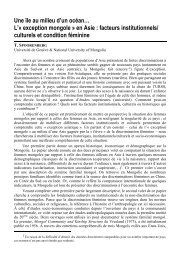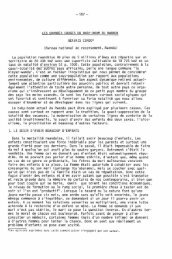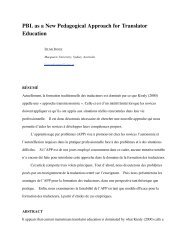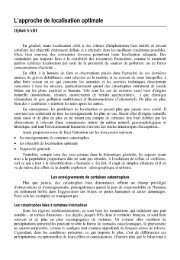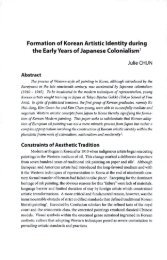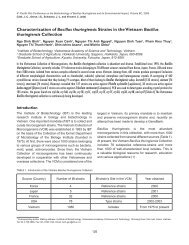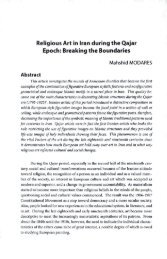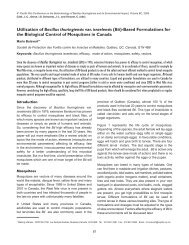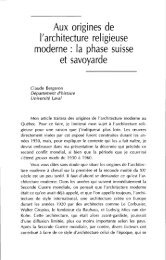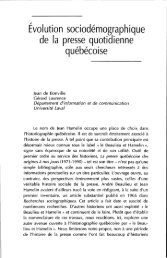A Proactive Approach to the Translation of Bible Stories for Children
A Proactive Approach to the Translation of Bible Stories for Children
A Proactive Approach to the Translation of Bible Stories for Children
You also want an ePaper? Increase the reach of your titles
YUMPU automatically turns print PDFs into web optimized ePapers that Google loves.
empty puff <strong>of</strong> smoke (a la <strong>the</strong> comic strips), above his head. The text echoes <strong>the</strong> “emptiness” left<br />
by <strong>the</strong> absence <strong>of</strong> <strong>the</strong> vertical motif: “When Jacob fell asleep he had a dream. God <strong>to</strong>ld him<br />
everything was going <strong>to</strong> be alright, …” (Larsen 1995: 120). The audience is left with a sense <strong>of</strong><br />
horizontal continuation in narrative and image, thus depriving <strong>the</strong> reader <strong>of</strong> any imaginary<br />
component, as so eloquently provided by <strong>the</strong> mix <strong>of</strong> myth and fantasy in <strong>the</strong> original account. An<br />
even more explicit negation <strong>of</strong> <strong>the</strong> vertical imagery is found where <strong>the</strong> stairs are indicated, but<br />
running more or less horizontally across <strong>the</strong> picture frame (ONS GROOT PRENTEBYBEL 2000:<br />
n.p.).<br />
4.5.3 The Position <strong>of</strong> <strong>the</strong> Deity<br />
The lack <strong>of</strong> a vertical relationship mentioned in Larsen’s (1995: 120) rendering, also contributes <strong>to</strong><br />
<strong>the</strong> establishment <strong>of</strong> a horizontal, ra<strong>the</strong>r than hierarchical relationship between <strong>the</strong> two parties<br />
involved: God and Jacob. Matters such as Jacob’s “fear ”, after <strong>the</strong> event, <strong>the</strong>re<strong>for</strong>e has <strong>to</strong> be left<br />
untranslated as a result, as it cannot be explained without a sense <strong>of</strong> <strong>the</strong> overpowering awesomeness<br />
<strong>of</strong> a deity coming down from heaven <strong>to</strong> concern himself with <strong>the</strong> affairs <strong>of</strong> humanity. It <strong>the</strong>re<strong>for</strong>e<br />
affects <strong>the</strong> relational depiction <strong>of</strong> <strong>the</strong> space between God and humanity and makes it difficult <strong>for</strong> <strong>the</strong><br />
child <strong>to</strong> understand <strong>the</strong> reason <strong>for</strong> Jacob’s “fear” which Larsen (1995: 89) has <strong>to</strong> convert in<strong>to</strong> a<br />
fear <strong>for</strong> <strong>the</strong> uncertainties that <strong>the</strong> future might hold, ra<strong>the</strong>r than a fear <strong>of</strong> God, as no relational<br />
depiction <strong>of</strong> God vis-à-vis Jacob is given in <strong>the</strong> rendering <strong>of</strong> <strong>the</strong> s<strong>to</strong>ry.<br />
Also, as mentioned be<strong>for</strong>e, in <strong>the</strong> Hebrew source text <strong>the</strong> position <strong>of</strong> God is in no way related<br />
<strong>to</strong> <strong>the</strong> stairwell and <strong>the</strong> activities <strong>of</strong> <strong>the</strong> angels 15 . God is positioned in relation <strong>to</strong> Jacob: “above” or<br />
“on ” or “on <strong>to</strong>p <strong>of</strong>” Jacob (Hebrew: ‘al), <strong>the</strong>reby indicating <strong>the</strong> authority in <strong>the</strong> relationship<br />
between <strong>the</strong> two entities in <strong>the</strong>ir spatial interaction.<br />
4.6 The Text and Pictures in <strong>the</strong> Afrikaans Translated Versions<br />
Van der Watt & Joubert (2002) in yet ano<strong>the</strong>r attempt <strong>to</strong> draw <strong>the</strong> 21 st century child between <strong>the</strong><br />
ages <strong>of</strong> five and eight in<strong>to</strong> <strong>the</strong> s<strong>to</strong>ry depicts a ra<strong>the</strong>r young Jacob peacefully asleep with his dog by<br />
his side. Ryken et al. (1998: 29) points out that <strong>the</strong> bible invokes <strong>the</strong> image <strong>of</strong> <strong>the</strong> dog quite <strong>of</strong>ten,<br />
but rarely in a positive light. The Israelites were familiar with dogs, not as cherished pets, but as<br />
members <strong>of</strong> packs that fed at <strong>the</strong> <strong>to</strong>wn dump and roamed <strong>the</strong> streets at night howling (Psalm 59:6).<br />
The struggle <strong>for</strong> survival at <strong>the</strong> <strong>to</strong>wn dump and a semi-wild existence did not produce friendly dogs.<br />
Dogs seemed <strong>to</strong> know nothing <strong>of</strong> obedience and were dangerous <strong>to</strong> pet (Proverbs 26:17). The fear<br />
<strong>of</strong> being eaten by such dogs was real (Psalm 22:16-17).<br />
What is more problematic about this picture is <strong>the</strong> very rare representation <strong>of</strong> God, in human<br />
guise, on <strong>the</strong> stairwell. The text emphasizes a verse (Genesis 28:13) from <strong>the</strong> 1983-translation <strong>of</strong><br />
<strong>the</strong> Afrikaans bible, which states that God came and s<strong>to</strong>od by Jacob and spoke <strong>to</strong> him. (In <strong>the</strong> Old<br />
Afrikaans Version, as is <strong>the</strong> case <strong>for</strong> <strong>the</strong> King James Version, God is indicated as standing at <strong>the</strong><br />
very <strong>to</strong>p <strong>of</strong> <strong>the</strong> ladder.) Never<strong>the</strong>less, <strong>the</strong> Hebrew source text refers <strong>to</strong> God’s position as “on” or<br />
“on <strong>to</strong>p <strong>of</strong>” Jacob and not necessarily relational in position <strong>to</strong> <strong>the</strong> stairwell. And as has been<br />
pointed out, this is hierarchically significant in terms <strong>of</strong> positioning <strong>of</strong> sacred versus pr<strong>of</strong>ane; but<br />
also in terms <strong>of</strong> authority, God is by virtue <strong>of</strong> position, superior <strong>to</strong> Jacob.<br />
The <strong>to</strong>ne expressed through this picture does not fit <strong>the</strong> awe and respect (“fear”) expressed<br />
in <strong>the</strong> text, as <strong>the</strong> picture is typically overshadowed by conceptual diminutives: God is small and<br />
caricaturised, <strong>the</strong> ladder (not stairs) is short, <strong>the</strong> emotionless Jacob is very young (Jacob was at least<br />
middle aged), with a small dog by his side.<br />
The conceptual diminutives are <strong>of</strong>ten underscored in older Afrikaans children’s bibles by a<br />
natural tendency in Afrikaans <strong>to</strong> fill speech and text aimed at children with <strong>the</strong> diminutive <strong>for</strong>m, <strong>for</strong><br />
example, “little angels” (Afrikaans: engeltjies), and so <strong>for</strong>th (see, De Vries & Geldenhuys n.d.:<br />
36). But in older texts <strong>the</strong> deity is authority figure is upheld by not applying <strong>the</strong> same diminutive<br />
status <strong>to</strong> God in ei<strong>the</strong>r illustration or text. Thereby expressing <strong>the</strong> power relationship between God<br />
and Jacob in terms <strong>of</strong> big (important) vs. small (less important), ra<strong>the</strong>r than as high vs. low, as is <strong>the</strong><br />
case in <strong>the</strong> source text.



